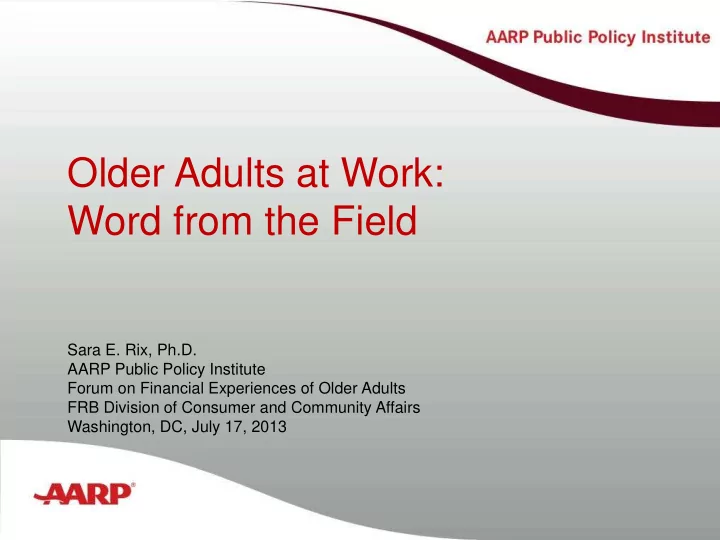

Title text here Older Adults at Work: Word from the Field Sara E. Rix, Ph.D. AARP Public Policy Institute Forum on Financial Experiences of Older Adults FRB Division of Consumer and Community Affairs Washington, DC, July 17, 2013
Full-and Part-time Employment of Workers Aged 65+, 1980 – 2012* 65% Part-time 60% 55% 50% 45% Full-time 40% 35% 30% 1980 1981 1982 1983 1984 1985 1986 1987 1988 1989 1990 1991 1992 1993 1994 1995 1996 1997 1998 1999 2000 2001 2002 2003 2004 2005 2006 2007 2008 2009 2010 2011 2012 *Part-time is less than 35 hours per week. Source: AARP PPI calculations using the Current Population Survey, March supplements.
What’s Very Important to Older Workers? Ages 50-59 Ages 60-69 70% 58% 37% 34% 31% 28% 27% 26% 20% 19% 19% 14% Paid time off Flex time Formal phased Compressed Telecommuting Job sharing retirement schedule Source: S. Kathi Brown, What Are Older Workers Seeking? An AARP/SHRM Survey of 50+ Workers, 2012 at http://www.aarp.org/content/dam/aarp/research/surveys_statistics/econ/2012/What-Are-Older-Workers-Seeking- An-AARP-SHRM-Survey-of-50-Plus-Workers-AARP.pdf.
Access to Paid Time Off in Private Industry, March 2012 All Lowest 25% Wages* Highest 25% Wages* 91% 90% 84% 77% 77% 61% 50% 49% 29% Sick Leave Vacation Holidays *Based on average wage in category. Source: U.S. Department of Labor, Bureau of Labor Statistics, Employee Benefits in the United States—March 2012 , July 11, 2012 at http://www.bls.gov/news.release/pdf/ebs2.pdf.
Flexible Work Options Offered by Employers* 87% Time for fam/personal matters 55% 77% Periodically change start/quit time 27% 39% Daily change start/quit time 9% 63% Occasionally work at home 6% 33% Regularly work at home 2% To some 53% Phase into retirement employees 17% 36% To all/most Compress work week 7% employees 18% Work part year 2% *With 50 or more employees. Source: Kenneth Matos and Ellen Galinsky, 2012 National Employer Survey (New York: Families and Work Institute, 2012) at http://familiesandwork.org/site/research/reports/NSE_2012.pdf.
Reasons for Work-Life Initiatives (mentioned by at least 10% of employers*) Retain employees in general 37% Help employees manage work/family life 16% Improve morale 12% Mandated by law 12% Retain highly skilled employees 12% Recruitment 11% Right thing to do 11% *With 50 or more employees; asked of employers with a least eight family-friendly policies. Source: Kenneth Matos and Ellen Galinsky, 2012 National Employer Survey (New York: Families and Work Institute, 2012) at http://familiesandwork.org/site/research/reports/NSE_2012.pdf.
Title text here Contact Us: Sara Rix Senior Strategic Policy Advisor srix@aarp.org AARP Public Policy Institute www.aarp.org/ppi Twitter:@AARPpolicy www.Facebook.com/AARPpolicy Blog: www.aarp.org/policyblog
Recommend
More recommend